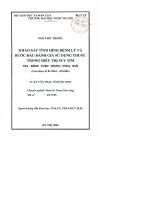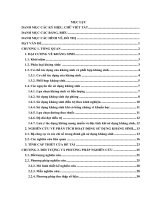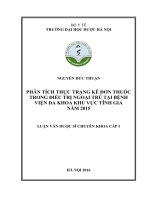Đánh giá kết quả truyền ối điều trị thiểu ối tại bệnh viện đa khoa vinmec_Tiếng Anh
Bạn đang xem bản rút gọn của tài liệu. Xem và tải ngay bản đầy đủ của tài liệu tại đây (535.59 KB, 15 trang )
<span class='text_page_counter'>(1)</span><div class='page_container' data-page=1>
<b>VINMEC INTERNATIONAL HOSPITAL </b>
<b>EFFECT ASSESMENT OF AMNIOINFUSION </b>
<b>TO TREAT OLIGOHYDRAMNIOS </b>
<b>AT VINMEC INTERNATIONAL HOSPITAL </b>
<b>MD. Nguyễn Thu Hoài</b>
</div>
<span class='text_page_counter'>(2)</span><div class='page_container' data-page=2>
<b>BACKGROUND </b>
<b>Oligohydramnios is defined when the amniotic volume is less than </b>
<b>normal ( depend on gestational age ) and membra intact, diagnosis by </b>
<b>ultrasound. </b>
<b>Many reasons lead to oligohydramnios: fetal defects, placenta </b>
<b>function restriction, IUGR… </b>
<b>Many effect for fetus, especial early appearance and long duration. </b>
<b>Most common effect : pulmonary hypoplasia, congenital malformation, </b>
<b>fetal distress, stillbirth… </b>
</div>
<span class='text_page_counter'>(3)</span><div class='page_container' data-page=3>
<b>BACKGROUND </b>
<b>Many methods have been used to treat amniotic fluid, such as </b>
<b>infusion of mothers, antibiotics, but not yet effective. </b>
<b>Amniocentesis is a technique first described for the treatment of </b>
<b>severe oligohydramnios in order to reduce the risk of pulmonary </b>
<b>hypoplasia in Japan (Nakayama et al, 1983). </b>
<b> Since then, amnioinfusion has been described as one of the </b>
<b>techniques of fetal intervention for the treatment of oligohydramnios </b>
</div>
<span class='text_page_counter'>(4)</span><div class='page_container' data-page=4>
<b>OBJECTIVES </b>
<b>1.</b> <b>Evaluate some conditions and criteria of amnioinfusion </b>
<b>procedure </b>
</div>
<span class='text_page_counter'>(5)</span><div class='page_container' data-page=5>
<b>SUBJECTS </b>
<b>Pregnant women having oligohydramnios and agree to be treated </b>
<b>with amnioinfusion </b>
<b>Include characteristic </b> <b>Exclude chcharacteristic </b>
- <b>Gestational age: 15w – 35w </b>
<b>Fetal HR (+) </b>
- <b>AFI < 50 mm </b>
- <b>Agreement involve study </b>
- Stillbirth
- Feat malfomation finding in
US
- Rupture of membranes
- Non agreement
- Abnomal fetal chromosome
</div>
<span class='text_page_counter'>(6)</span><div class='page_container' data-page=6>
<b>METHOD </b>
<b>Prospective study </b>
<b>Sample size: all patients who met the selection criteria and </b>
<b>exclusion criteria were given amnioinfusion </b>
</div>
<span class='text_page_counter'>(7)</span><div class='page_container' data-page=7>
<b>PROCEDURE </b>
<b>Patients were examined, diagnosed with amniohydramnios, exclude </b>
<b>rupture membranes, noninfection </b>
<b>Technology: </b>
<b>- Carry out at the operating room, sedative +/- </b>
<b>- Use 22G needle, US guide </b>
<b>- Natriclorid 0.9%. 200-500ml each time depend on gestational age, </b>
<b>and AFI, transfer rate 5-10ml / min </b>
<b>- Amniotic fluid sample for genetic test, infection test. </b>
<b>- Inpatient 2 days after surgery, tocolytic if needed </b>
</div>
<span class='text_page_counter'>(8)</span><div class='page_container' data-page=8>
<b>RESULTS </b>
<b> Maternal age </b>
0
0.5
1
1.5
2
2.5
30 31 32 33 34 35 36 37 38 39 40
</div>
<span class='text_page_counter'>(9)</span><div class='page_container' data-page=9>
<b>RESULTS </b>
<b>Gestational age and follow up after Amnioinfusion</b>
<b>Biểu đồ 1: Tuổi thai phụ nghiên cứu </b>
<i>Mean time continue pregnancy: 6,8 ± 5,4 weeks </i>
<i>6 cases continue pregnancy more than 35 weeks ( 5 cases than 37 weeks- </i>
<i>83,33%) </i>
<b>Gestational age group </b> <b>Gestational age </b>
<b>(week) </b>
<b>Time continue </b>
<b>pregnancy </b>
<b>Gestational age </b>
<b>in terminal </b>
<b>< 22 weeks </b> 17 01 18
<b>22 - 28 weeks </b> 26 01 27
22 16 38
<b>28 - 32 weeks </b>
28 10 38
29 10 39
29 10 39
<b>>32 weeks </b> 32 03 35
33 04 37
</div>
<span class='text_page_counter'>(10)</span><div class='page_container' data-page=10>
<b>RESULTS </b>
<b>Volume infusion, time of procedure and time performing: </b>
<i>.</i>
<b>Gestational age </b>
<b>group </b>
<b>Gestational age </b>
<b>(week) </b>
<b>Volume(ml)</b> <b>Procedure time </b>
<b>(minutes)</b>
<b>Time </b>
<b>performing </b>
<b>< 22 weeks </b> <sub>17 </sub> <sub>300</sub> <sub>20</sub> <sub>1 </sub>
<b>22 - 28 weeks </b> <sub>26 </sub> <sub>300</sub> <sub>20</sub> <sub>1 </sub>
22 500 ( 1st: 250ml
2nd: 250ml)
65 ( 1st: 30 min
2nd: 35 min)
2
<b>28 - 32 weeks </b> <sub>28 </sub> <sub>350</sub> <sub>50 </sub> <sub>1</sub>
29 300 30 1
29 200 35 1
<b>>32 weeks </b> <sub>32 </sub> <sub>300</sub> <sub>25 </sub> <sub>1</sub>
33 350 40 1
</div>
<span class='text_page_counter'>(11)</span><div class='page_container' data-page=11>
<b>RESULTS </b>
<b>The change of AFI after amnioinfusion </b>
<i>1 case recurrent oligohydramnious need to be infusion twice times </i>
<i>6 cases progress (5 case AFI > 80) </i>
<i>Total: 7/8 cases had a good results (87,5%) </i>
</div>
<span class='text_page_counter'>(12)</span><div class='page_container' data-page=12>
<b>RESULTS </b>
<b>Newborn characteristic </b>
1 cases miscariage at 17 weeks of pregnancy, the other newborn
- Jaundice: 1 case (14,3%)
- Newborn need respiration support: 0 %
- Malformation:0%
- Infection: 0%
- IUGR: 14,3%
- Fetal death: 1 case (14,3%) (in case twin- 1 still birth+ 1
olygohydramnios)
</div>
<span class='text_page_counter'>(13)</span><div class='page_container' data-page=13>
<b>CONCLUSIONS </b>
</div>
<span class='text_page_counter'>(14)</span><div class='page_container' data-page=14></div>
<span class='text_page_counter'>(15)</span><div class='page_container' data-page=15></div>
<!--links-->









